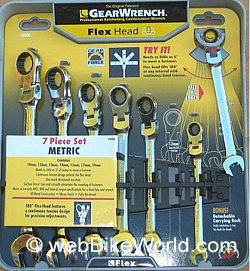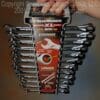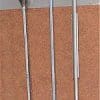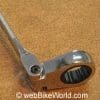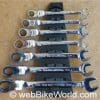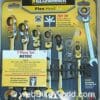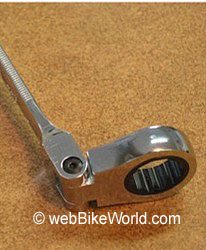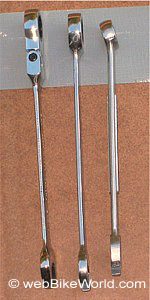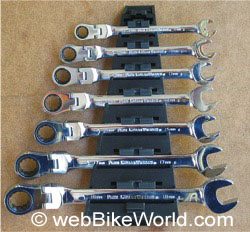The GearWrench Flex Head wrench has excellent quality, appearance and feel.
They are made from highly polished chrome.
They’re light weight, thin and the Flex Head rotates 180 degrees.
It needs as little as 5 degrees of sweep to move a fastener.
The tools come with a lifetime warranty and the Flex Head is secured with hex screw, not pinned.
Washers provide continuous tension so Flex Head keeps position.
Also, new “One Touch Assistant” knurling on handle provides reference to which side of the wrench is the drive end.
“The right tool for the job”.
It took me decades to learn the implications of that simple statement.
My Dad was what you might colloquially term a “farm mechanic”, and he’s also an inveterate bargain hunter.
Although he was willing enough, you didn’t want him around anything that needed repair.
He took great pride in buying the fewest number of the cheapest multi-head pot metal tools he could find.
And I can tell you this for sure — cheap tools were really, really bad in those days!
Combine junk tools with aluminum engine casings and “urban myth” mechanical know-how and, well, you’ve got a recipe for disaster!
Even with those lessons learned from watching my Dad, it still took me a long time to learn to appreciate high-quality tools and to overcome the generational guilt of spending real money on them.
I began to understand how much easier and pleasurable a project can be with the perfect tool for the job.
My father still gets on my case for spending “good money” on name brand tools, but now I just laugh it off and humor him.
Tools and You
I’ve also learned that many motorcyclists don’t even change their own oil, preferring instead to have a dealer or repair shop do it for them.
I don’t have a problem with that, understanding that it’s not always easy to find the time or the space to perform basic repairs or maintenance.
But it’s also apparent that many owners don’t even have a decent selection of quality hand tools.
They rely instead on a combination of the usually chintzy tool kit under the bike’s seat and whatever screwdriver happens to be in the kitchen’s junk drawer.
The right tool can make a job much easier, and perhaps even give one the confidence to tackle the job in the first place.
I also believe that working on our motorcycles adds depth to the complex relationship that we have with them.
I secretly think of my bikes as living, breathing creatures with their own personalities.
Touching, wrenching, cleaning and filling them with high-quality vital fluids helps me to know and understand them that much better.
Besides…I’m not sure if it has to do with being born in East New York, but there aren’t many strangers I trust, especially when it comes to my bikes.
I like to know that my bolts are properly torqued and everything is correctly adjusted according to specifications.
Sure, I’ve made many bonehead mistakes (usually falling in the “haste makes waste” category), but in the end, the sole responsibility of my bike’s safety and performance is in my own hands.
So I never spare an expense if I find a tool that’s just right for a particular job.
Tool junkies will understand — you can never have enough tools, because you never know when you’ll need precisely the tool you don’t have (and you’ll always need just one more!).
Motorcycles help feed this addiction; their increasing complexity and the recent design trend towards centralized mass are making it more and more difficult to access the basic maintenance and repair items.
Acres of hard-to-remove fairing bits don’t help either.
Since there’s a close correlation between complexity, decreasing size and maintenance headaches, the only defense is to own the specialized tools that can make it easier to get the job done.
Which Brings Us to GearWrench…
We’ve been fans of GearWrench products for some time — our first experience with theGearWrench combination wrenches (review) found them to be very useful for working on motorcycles.
Their narrow profile and patented ratcheting box end that only needs 5 degrees of movement (vs. 30 degrees in standard 12-point box end wrenches) can really come in handy when working in the tight quarters of a motorcycle.
There’s more than a few jobs I can think of for which a GearWrench is worth its weight in gold.
For example, the thin GearWrench and its short-distance ratcheting ability make it so much easier to remove the bolts that hold the airbox and the transmission to the engine casing in my old BMW Airheads, literally shaving multiple minutes of tedious work from the job.
Stubby and Flex Head
Recently, the GearWrench folks have come up with a few new products, including “stubby” length GearWrench combination wrenches and the new “Flex Head” GearWrench, the subject of this review.
The flexible head for the box end makes the original GearWrench concept even more useful for working on motorcycles.
The box end of the GearWrench Flex Head can be rotated through 180 degrees of movement to offset its position, which can make a huge difference in the ability to access nuts or bolts within the hidden depths of a motorcycle’s chassis.
The Flex Head GearWrenches are made with the same high quality as the original.
They have a nice, sleek feel due to their highly polished chrome.
And the combination of their thin profile, flexible head and their ability to ratchet with only 5 degrees of movement makes them ideal.
The flexible head is mounted to the body of the wrench by a long hex screw, rather than a cheap pressed pin.
This provides strength and helps eliminate wear and tear in that crucial area.
There’s a spring steel washer hidden under the joint that provides enough tension to make the flexible head stay at whatever angle you set it to.
This is much more useful than other flex-end non-ratcheting box wrenches I’ve seen where the flexible end simply flops back and forth with no resistance, and which can slip and cause skinned knuckles.
GearWrench has also added a new feature to their wrenches, called the “One Touch Assistant”.
One side of the tool’s handle is knurled (photo left), which allows instant identification of the drive side.
This is a simple and elegant solution to the problem of trying to figure out which way the GearWrench box-end drive is working.
The knurled ridges could probably be slightly more aggressive for quicker identification.
But they still provide an easy method to determine which side is the drive side by feel alone.
This helps to orient the wrench one way or the other for either loosening or tightening the fastener.
Note that the GearWrench must be flipped over to change direction.
So in very rare instances when loosening a bolt with a limited amount of space both above and below the head of the bolt, you may reach a point where there is not enough clearance to remove the wrench from the head of the bolt.
Or, not enough room to slide it down over the bolt head, so there’s a potential to end up with a wrench that is stuck.
This is an extremely rare condition, and the benefits of the GearWrench far outweigh this drawback.
It happened to me once, but the bolt was out far enough to grasp with a pair of needle nose pliers so that I could turn it back in enough to remove the GearWrench.
Surface Drive
The GearWrench Flex Head wrenches also use the GearWrench “Surface Drive” box end, which, they claim, “virtually eliminates the rounding of fasteners”.
The Surface Drive provides a flat area on each side of the box end, which is claimed to distribute the load over a wider area when removing or tightening a fastener, helping prevent the rounding of hex nuts when applying force.
I did a quick comparison of a 13mm GearWrench Flex Head with a 13mm Sears Craftsman basic wrench and a 13mm standard GearWrench.
It’s interesting to note that the thick-handled basic Craftsman is the same weight as the thinner GearWrench, but the GearWrench has more mass located around the box end, making up the difference.

All GearWrench products carry a lifetime warranty and are claimed to “meet or exceed ANSI, DIN and U.S. Federal torque specifications for standard professional combination wrenches”.
Note that the box end of the Flex Head or other GearWrenches are not designed to loosen frozen or over-torqued fasteners.
Use ‘Em Right
Knowing how to use a tool is as important as using the right one; this means that a frozen or heavily torqued nut or bolt should first be loosened with the correct tool, such as a non-ratcheting 6-point socket or wrench.
The GearWrench is a precision tool — don’t yarn on the end of one with a cheater bar and expect the ratcheting box end to hold up. Common sense applies here…
The GearWrench FlexHead combination wrench is available in Metric and SAE sizes.
They’re sold individually or in sets.
The sets come with a nice tool holder.
Each GearWrench can be clipped into a spot on the holder, which can fit inside most toolbox drawers.
The 7-piece Metric set shown here consists of a 10mm, 12mm, 13mm, 14mm, 15mm, 17mm and 19mm wrenches.
There’s a 12-piece Metric set that adds an 8mm, 9mm, 11mm, 16mm and 18mm.
The 12-piece set is just the ticket for working on motorcycles, because it contains about every size wrench you’ll probably need.
A 7-piece SAE set is also available, consisting of 3/8, 7/16, 1/2, 9/16, 5/8, 11/16 and 3/4 inch wrenches.
GearWrench products are designed in the U.S.A. by the Danaher Tool Group and manufactured to specifications in Taiwan.
The Danaher Tool Group also owns KD Tools, which are specialty automotive tools found in almost every auto parts shop.
| wBW Review: GearWrench Flex Head | |
|---|---|
| Manufacturer: GearWrench | List Price (2004): $69.99 (7 set), $149.99 (12 set) |
| Colors: Polished chrome | Made In: Taiwan |
| Review Date: January 2004 | |
Owner Comments and Feedback
See details on submitting comments.


